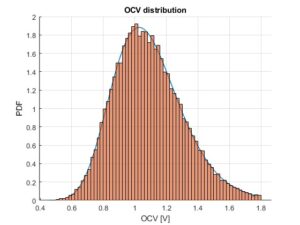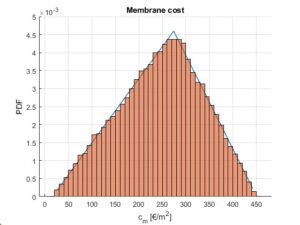The UniPI team has recently added a stochastic dimension to the analysis of Aqueous Organic Redox Flow Battery (AORFB) systems studied during the project in order to compensate the lack of literature data and to increase the reliability of the results.
Monte Carlo method was applied to evaluate how uncertainties associated with key battery input parameters can impact the relevant technical, e.g. energy and power, and economic, e.g. specific capital cost and Levelized Cost of Storage (LCOS) outputs.
The stochastic analysis included the following parameters: degradation rates, namely cycle fade and calendar fade, Open Circuit Voltage (OCV), current density, internal resistance, crossover losses, membrane cost, bipolar plate cost, and electrode felt cost. As these parameters are subject to uncertainty, they were expressed through probability distributions rather than exact values.
The images below show some of the specified probability distributions.


Why performing a stochastic analysis?
The Monte-Carlo simulation method – which uses random values rather than of ad hoc variations of the input-parameters like in a sensitivity analysis – quantifies the possible changes in the performance outputs and the probability of these happening. These result from simultaneous combined interactions of uncertainties in all selected input parameters.
